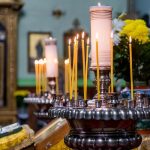Buddhist funerals may appear serene on the surface, but beneath the chanting and incense lies a complex system of symbols that guide the spirit onward. Every item present, from folded robes to flickering candles, holds a purpose deeper than meets the eye. These rituals aren’t about pomp; they’re about meaning, memory and merit, all thoughtfully included in a Buddhist funeral package.
A Final Journey Framed by Symbols
In Buddhist belief, death isn’t an end, but a transition. Symbols help make this transition smoother for the departed and their loved ones. One common sight at such ceremonies is the presence of monks. Dressed in saffron or maroon, their robes signify detachment from the material world. Their presence brings spiritual guidance, offering chants believed to aid the soul’s passage into the next life.
Incense sticks are another core symbol. When lit, they represent the impermanence of life. The smoke, gently rising, is thought to carry prayers upward. A funeral director in Singapore who specialises in Buddhist rites will usually ensure the placement of incense holders at the altar is just right, with the right amount and timing to avoid distraction or disruption.
Robes, Rituals, and Respect
The traditional colour of mourning in many Asian cultures is white, which holds true in Buddhist funerals. Mourners usually wear white or plain clothing to represent humility and respect. The simplicity in clothing reflects a quiet letting go, not just of the person, but of worldly attachments. Sometimes, a headband or sash may be tied around the head or chest of close family members.
Candles are often placed on the altar. These aren’t just to set the mood. In Buddhist thought, light represents wisdom that dispels the darkness of ignorance. A candle burning at the altar symbolises the presence of Dharma, guiding the deceased even after death.
A quality Buddhist funeral package typically includes all of these symbolic elements. While the setup may differ slightly between traditions, such as Mahayana, Theravada or Vajrayana, the core elements remain rooted in the same ideas of guidance, release and remembrance.
Chanting and Sound: The Voice of the Ritual
Chanting plays a large part in Buddhist funerals. It is more than a recital; it’s a form of spiritual support. Sutras such as the Heart Sutra or Amitabha Sutra are chanted to generate positive karma for the deceased. The sound itself is thought to create a soothing energy field around the body and the mourners. It’s not a concert, though; it’s a collective prayer.
Families often seek help from a funeral director in Singapore to arrange for monks or nuns familiar with the appropriate chants. Timing and sequence matter. The chanting starts at the wake, continues through the funeral service, and sometimes even days after, depending on the family’s wishes.
Food and Offerings: A Farewell Feast
Fruits, rice and vegetarian dishes are often placed on the altar as offerings. These aren’t for the living, though guests may later partake. The food is symbolic of generosity and nourishment, meant to ease the spirit’s journey and show continued care. Paper offerings, such as lotus flowers or even paper-made daily items, are also common. When burnt, they symbolically transfer to the spirit world.
Some families include photos of the deceased, framed in white or placed on an altar. While not originally a Buddhist practice, this modern adaptation personalises the funeral while staying within the framework of respect and mindfulness.
Flags, Flowers and Final Touches
Small Buddhist flags or lotus flower motifs may be used as decoration. These serve as reminders of teachings and rebirth. The lotus, for instance, grows in muddy water but blooms beautifully, symbolising purity emerging from difficulty. These floral symbols offer quiet comfort in a setting that often feels heavy.
A professional Buddhist funeral package may include curated decorations that stay faithful to the rituals without overwhelming the space. It’s a careful balancing act between tradition and comfort, and it’s where experienced guidance becomes essential.
Why These Symbols Still Matter Today
In a fast-paced city like Singapore, traditions can often feel sidelined by convenience. But in times of grief, many families still turn to Buddhist rituals because of the comfort found in these symbols. They may not be flashy, but they hold generations of meaning. From the moment the wake begins to the final rites at the crematorium, every element serves to honour, release and remember.
A funeral director in Singapore familiar with Buddhist customs becomes more than just a service provider. They’re a guide through unfamiliar terrain, helping families focus on mourning rather than logistics. The right help ensures no symbol is overlooked, and nothing meaningful is lost in translation.
Honour Through Rituals That Speak Without Words
Buddhist funerals aren’t about large displays. They’re quiet but full of signs, smoke, light, cloth, sound, all working together to help a soul let go and move forward. These symbols speak when words fail, and that’s their quiet strength.Contact Memorial Funeral Group to arrange a Buddhist funeral package that honours every symbol and respects every tradition.












